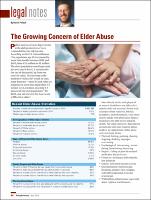Please use this identifier to cite or link to this item:
https://hdl.handle.net/20.500.12202/4731Full metadata record
| DC Field | Value | Language |
|---|---|---|
| dc.contributor.author | Pollack, Daniel | - |
| dc.date.accessioned | 2019-09-25T22:08:27Z | - |
| dc.date.available | 2019-09-25T22:08:27Z | - |
| dc.date.issued | 2013-04 | - |
| dc.identifier.citation | Pollack, Daniel. (April 2013). The Growing Concern of Elder Abuse. Policy & Practice 71(2): 28-29. | en_US |
| dc.identifier.issn | 1942-6828 | - |
| dc.identifier.uri | https://search.proquest.com/docview/1335300022?accountid=15178 | en_US |
| dc.identifier.uri | https://hdl.handle.net/20.500.12202/4731 | - |
| dc.description | Legal notes | en_US |
| dc.description.abstract | According to the U.S. Census Bureau, "the population age 65 is expected to more than double between 2012 and 2060, from 43.1 million to 92 million....Most elderly adults with physical or mental disabilities are able to live comfortably and securely. Either with assistance from relatives, friends, neighbors, or professionals, even those elderly adults with physical or mental disabilities are able to live independently. For some, however, dependence on someone else may result in abuse, neglect, or exploitation. Elder abuse can take many forms.: | en_US |
| dc.language.iso | en_US | en_US |
| dc.publisher | American Public Human Services Association-APHSA | en_US |
| dc.relation.ispartofseries | Policy & Practice;71(2) | - |
| dc.rights | Attribution-NonCommercial-NoDerivs 3.0 United States | * |
| dc.rights.uri | http://creativecommons.org/licenses/by-nc-nd/3.0/us/ | * |
| dc.subject | population | en_US |
| dc.subject | senior citizens | en_US |
| dc.subject | elder abuse | en_US |
| dc.subject | geriatrics | en_US |
| dc.title | The Growing Concern of Elder Abuse. | en_US |
| dc.type | Article | en_US |
| dc.contributor.orcid | 0000-0001-7323-6928 | |
| local.yu.facultypage | https://www.yu.edu/faculty/pages/pollack-daniel | |
| Appears in Collections: | Wurzweiler School of Social Work: Faculty publications | |
Files in This Item:
| File | Description | Size | Format | |
|---|---|---|---|---|
| art APHSA The growing concern of elder abuse.pdf | 751.04 kB | Adobe PDF |  View/Open |
This item is licensed under a Creative Commons License

